Writing a simple 16 bit VM in less than 125 lines of C
This tutorial is intended for C beginners who want to do some coding practice and in the process, gain valuable insights regarding low-level programming and how (some) Virtual Machines operate under the hood.
By the end of the article, we will have a working register-based VM capable of interpreting and running a limited set of ASM instructions + some bonus programs to test if everything works well.
The code is written in C11, and it will probably compile on most operating systems. The repo can be found here, and the exact source code is vm.c:
git clone git@github.com:nomemory/lc3-vm.git
If you are a seasoned C developer that has already dabbled in this sort of stuff, you can skip this reading because it will cover information you probably already know.
The reader should already be familiar with bitwise operations, hexadecimal notation, pointers, pointer functions, C macros, and some functions from the standard library (e.g., fwrite and fread).
If you are not familiar with bitwise operations, you can follow my tutorial here.
It will be unfair not to mention some existing blog posts covering the same topic as this article; the best in this category is Write your Own Virtual Machine by Justin Meiners and Ryan Pendleton. Their code covers a more in-depth implementation of a VM. Compared to this article, our VM is a little simpler, and the code takes a different route in terms of the implementation.
Later edit: After publishing this article in December, Philip Chimento was nice enough to write a Rust implementation of the same Virtual Machine. If you are curious to see how the solution looks like in another programming language, please check this out.
Table of contents
- Table of contents
- Virtual Machines
- von Neumann model
- Implementing the VM
- The Main Memory
- The registers
- The instructions
add- Adding two valuesand- Bitwise logical ANDld- Load RPC + offsetldi- Load indirectldr- Load Base+Offsetlea- Load effective addressnot- Bitwise complementst- Storesti- Store indirectstr- Store base + offsetjmp- Jumpjsr- Jump to subroutinesbr- Conditional branchtrap
- Loading and running programs
- Final thoughts
- Community links
Virtual Machines
In the world of computing, a VM (Virtual Machine) is a term that refers to a system that emulates/virtualizes a computer system/architecture.
Broadly speaking, there are two categories of Virtual Machines:
- System Virtual Machines which provide a complete substitute for a real machine. They implement enough functionality that allows operating systems to function on them. They can share and manage hardware, and sometimes multiple environments can function on the same physical machine without hindering each other.
- Process Virtual Machines which are simpler and are designed to execute computer programs in a platform-agnostic environment. The JVM is a good example of a Process Virtual Machine.
In this article, we will develop a simple Process Virtual Machine designed to execute simple computer programs in a platform-independent environment. Our toy Virtual Machine is based on the LC-3 Computer Architecture, and will be capable of interpreting and executing (a subset of) LC3 Assembly Code.
Little Computer 3, or LC-3, is a type of computer educational programming language, an assembly language, a type of low-level programming language. It features a relatively simple instruction set but can be used to write moderately complex assembly programs and is a viable target for a C compiler. The language is less complicated than x86 assembly but has many features similar to those in more complex languages. These features make it worthwhile for beginning instruction, so it is most often used to teach fundamentals of programming and computer architecture to computer science and computer engineering students. (wikipedia)
For simplicity, we deliberately stripped down our LC-3 implementation from the following features: interrupt processing, priority levels, process, status registers (PSR), privilege modes, supervisor stack, user stack. We will virtualize only the most basic hardware possible, and we will interact with the outside world (stdin, stdout) through traps.
von Neumann model
Our LC-3 inspired VM, like most of the general-purpose computers nowadays, is based on the von Neumann computer model, and it will have three main components: the CPU, the Main Memory, the input/output devices.

The CPU, an abbreviation for Central Processing Unit is the “circuitry” that controls and manipulates data. Furthermore, the CPU is divided into three layers: ALU, CU, and Registers.
ALU stands for Arithmetic/Logic Unit and represents the circuits that are actually carrying the instructions on the data (operations like ADD, XOR, Division, etc.).
CU, an abbreviation for Control Unit, coordinates the activities on CPU.
The registers are quickly accessible “slots” located at the CPU level. The ALU operates on registers. They come in small numbers (that’s a relative statement, as it depends on the architecture), so the amount of data that can be loaded inside the CPU is limited. We use registers to interact with the Main Memory. A typical scenario involves loading a memory location into a register, performing some changes, and putting the data back into memory.
The Main Memory is imagined as an extensive “array” of W words of N bits each. Program instructions and the associated data are stored in the main memory in a binary format. Each memory word contains either one instruction or program data (e.g., a number used for computation).
The Input/Output devices enable the computer to communicate with the outside world.
Implementing the VM
Our VM functions like this:
- We load the program into the main memory;
- In the
RPCregister, we keep the current instruction that we need to execute; - We obtain the Operation Code (first 4 bits) from the instruction and based on that, we decode the rest of the parameters.;
- We execute the method associated with the given instruction;
- We increment
RPCand we continue with the next instruction;
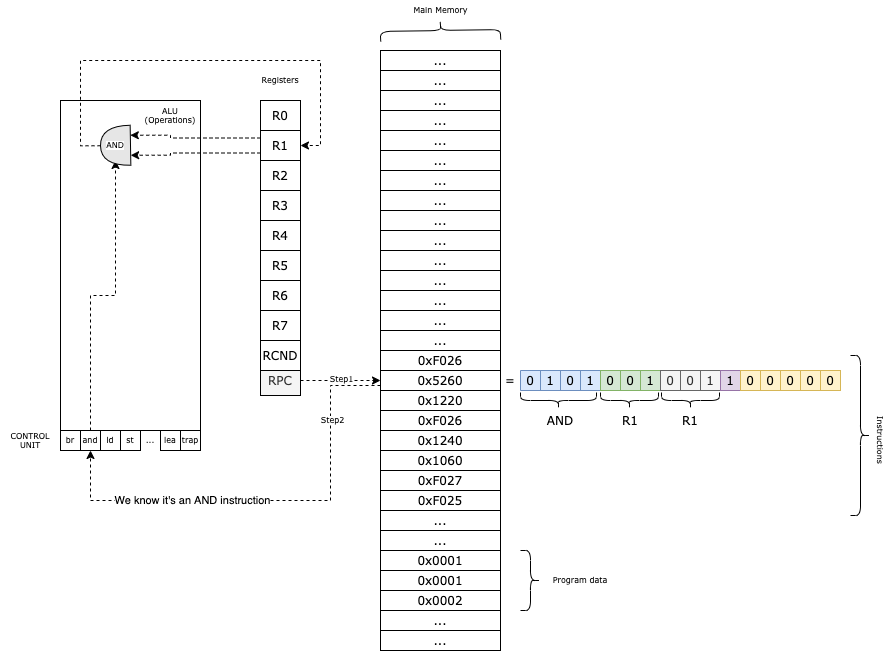
The Main Memory
Our machine has W=UINT16_MAX words, of N=16 bits each. From a C perspective our memory can be defined as:
uint16_t PC_START = 0x3000;
uint16_t mem[UINT16_MAX+1] = {0};
UINT16_MAX is the maximum size of a uint16_t (a unsigned 16 bits integer), UINT16_MAX=65535. So to put things into perspective, our system is quite limited. It won’t run/load programs with more than 65535 instructions. I know it sounds harsh for our current times, but computers were much more humble than this back in the day (a few decades ago). 65535 is more than enough to write a few ASCII games and keep them all in memory.
As a convention, we should start loading programs into the main memory from 0x3000 onwards. We keep the memory slots up to 0x3000 reserved for other potential components, for example, a toy operating system. But who has time for something like this?
At this point, it’s a good idea to write two functions for reading (mr(...)) and writing (mw(...)) to the main memory:
static inline uint16_t mr(uint16_t address) { return mem[address]; }
static inline void mw(uint16_t address, uint16_t val) { mem[address] = val; }
Even if this looks redundant to implement mr and mw (we can access the memory directly), in the future, we might add additional logic or impose some validations, so it’s a good idea to keep this functionality isolated.
The registers
Our VM has a total of 10 registers, 16 bits each:
R0is a general-purpose register. We are going to also use it for reading/writing data from/tostdin/stdout;R1,R2,..R7are general purpose registers;RPCis the program counter register. It contains the memory address of the next instruction we will execute.RCNDis the conditional register. The conditional flag gives us information about the previous operation that happened at ALU level in the CPU.
From a code perspective we can implement them as follows:
enum regist { R0 = 0, R1, R2, R3, R4, R5, R6, R7, RPC, RCND, RCNT };
uint16_t reg[RCNT] = {0};
To access a register, we simply: reg[R3]=....
The instructions
An instruction is like a command we give to the VM.
Through instructions, we ask the VM to perform a simple (and granular) task for us: read a char from the keyboard, add two numbers, perform a binary AND on a register, etc.
Instructions have the same word size as the memory, 16 bits. This is a natural decision; after all, we keep instructions loaded inside the Main Memory. So, from the C language perspective, instructions are uint16_t unsigned integers.
Our VM supports only a limited set of instructions: 16 (actually 14, because two LC-3 instructions didn’t make any sense to implement).
In terms of their format, instructions are usually encoded like this (inside a uint16_t):
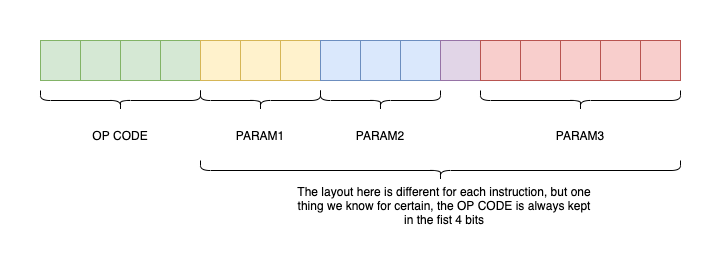
The first 4 bits are always the OpCode of the instruction. And then, depending on the instruction, there are 1,2,3,… params encoded in the remaining 12 bits.
Based on the OpCode, we can identify the instruction and understand how to “decode”/”extract” the rest of the params from the uint16_t.
For extracting the OpCode itself, we can write a utility macro that applies a simple bitwise trick:
#define OPC(i) ((i)>>12)
We shift 12 bits to the right (i>>12), to get the 4 most significant bits that contain the OpCode:

Because OpCodes are represented in 4 bits, the maximum number of instructions we can encode is 16 (2^4=16).
A nice trick we can perform in C (from a data modeling perspective) is to save all possible instructions (and their associated C functions) in an array. The index will represent the actual OpCode (after all, OpCodes are numbers from 0 to 15), and the value will be a pointer to the corresponding C function.
#define NOPS (16) // number of instructions
typedef void (*op_ex_f)(uint16_t instruction);
//
// ... other operations here
//
static inline void add(uint16_t i) { /* code here */ }
static inline void and(uint16_t i) { /* code here */ }
//
// ... other operations here
//
op_ex_f op_ex[NOPS] = {
br, add, ld, st, jsr, and, ldr, str, rti, not, ldi, sti, jmp, res, lea, trap
};
typedef void (*op_ex_f)(uint16_t i); is a typedef for a function pointer, that returns void and accepts one parameter the actual uint16_t instruction.
All instructions are now accessible if we know the OpCode:
uint16_t instr = ...;
op_ex[OP(instr)](instr); // this will execute the function associated with the OP(instr)
// For example if OP(instr)==0b0001 then we will execute add(instr)
// if OP(instr)==0b0010 then we will execute ld(instr)
// (and so on)
We can avoid writing a switch statement with 16 (+1) cases with this simple trick.
Now, let see what instructions our VM supports. As I’ve said earlier, I wasn’t original enough to come up with my own ASM, so I’ve decided to copy the instructions from the LC3 specification.
| Instruction | OpCode Hex | OpCode Bin | C function | Comments |
|---|---|---|---|---|
br |
0x0 |
0b0000 |
void br(uint16_t i) |
Conditional branch |
add |
0x1 |
0b0001 |
void and(uint16_t i) |
Used for addition. |
ld |
0x2 |
0b0010 |
void ld(uint16_t i) |
Load RPC + offset |
st |
0x3 |
0b0011 |
void st(uint16_t i) |
Store |
jsr |
0x4 |
0b0100 |
void jsr(uint16_t i) |
Jump to subroutine |
and |
0x5 |
0b0101 |
void and(uint16_t i) |
Bitwise logical AND |
ldr |
0x6 |
0b0110 |
void ldr(uint16_t i) |
Load Base+Offset |
str |
0x7 |
0b0111 |
void str(uint16_t i) |
Store base + offset |
rti |
0x8 |
0b1000 |
void rti(uint16_t i) |
Return from interrupt (not implemented) |
not |
0x9 |
0b1001 |
void not(uint16_t i) |
Bitwise complement |
ldi |
0xA |
0b1010 |
void ldi(uint16_t i) |
Load indirect |
sti |
0xB |
0b1011 |
void sti(uint16_t i) |
Store indirect |
jmp |
0xC |
0b1100 |
void jmp(uint16_t i) |
Jump/Return to subroutine |
0xD |
0b1101 |
Unused OpCode | ||
lea |
0xE |
0b1110 |
void lea(uint16_t i) |
Load effective address |
trap |
0xF |
0b1111 |
void trap(uint16_t i) |
System trap/call |
Regarding their order, instructions can be grouped together (based on their functionality) into 4 main categories:
br,jmp,jsrare used for the control flow of our programs: jumping from one instruction to another (similar to ago tostatement) or conditional jumping (similar to anifstatement);ld,ldr,ldi,leaare used to to load data from the main memory to the registers;st,str,stiare used to store data from the registers back to the main memory;add,and,notare performing (mathematical) operations on the data kept in the registers.
trap is a special instruction that will enable us to interact with the keyboard (read characters or numbers), and print information on stdout.
As you notice, our VM won’t have a lot of functionality in terms of actual mathematical operations. For example, there’s no XOR, and no division or multiplication. The good news is that we can implement them as an exercise to learn more about ASM. It’s not going to be easy, but it’s possible, and it’s a good practice to know more about ASM.
But before jumping into the implementation for each instruction, we must note that some operations have additional “side-effects” on the registers.
RCND, also known as the conditional register flag, is used to “track” additional information for some instructions. In our implementation it can have only three values:
1<<0(P from positive) - if the last operation yielded a positive result;1<<1(Z from zero) - if the last operation yielded 0;1<<2(N from negative) - if the last operation yielded a negative result;
The reason we have RCND is to help us with branching. For example, we want to see if a number a is bigger than another number b. We can calculate their difference, and if the result is a negative number, RCND is 1<<2. Then we can use the br instruction to jump to another instruction, just like using an IF statement in a high-level programming language.
From a code perspective, this can be implemented in C as:
enum flags { FP = 1 << 0, FZ = 1 << 1, FN = 1 << 2 };
static inline void uf(enum regist r) {
if (reg[r]==0) reg[RCND] = FZ; // the value in r is zero
else if (reg[r]>>15) reg[RCND] = FN; // the value in r is z negative number
else reg[RCND] = FP; // the value in r is a positive number
}
We call uf(r), after each operation that has the “side-effects” we want to test for.
In case you are not familiar with bitwise operations, you might wonder what kind of magic is this: else if (reg[r]>>15).
Our VM supports negative numbers (don’t get confused by the fact we’ve used uint16_t as the underlying memory type). As a convention, negative numbers have their most significant bit 1 (sitting on position 15).

add - Adding two values
Having the ability to add two numbers is essential for the VM we are building. In this regard, we will define two add instructions. Both of them will have the same OpCode, but the rest of the encoding will be different. bit[5] is the one that tells us which version of the add instruction we pick.
The first one (add1) is used for adding the values of two registers: SR1, SR2, and storing their sum in DR1:

The second one (add2) is used to add a “constant” value (IMM5) to SR1, and store the result in DR1:

Note: DR stands for Destination Register. SR stands for Source Register.
IMM5 is a positive or negative number on 5 bits. The most significant bit of those 5 is the sign bit. We need to keep this in consideration when we are writing our code. In this regard, we have to write a function that extends the sign to make it compatible with the 16 bits format:
#define SEXTIMM(i) sext(IMM(i),5)
static inline uint16_t sext(uint16_t n, int b) {
return ((n>>(b-1))&1) ? // if the bth bit of n is 1 (number is negative)
(n|(0xFFFF << b)) : n; // fill up with 1s the remaining bits (15)
// else return the number as it is
}
Visually, SEXTIMM(i) works like this (if the number is negative):

If the number is positive, we don’t have to perform any change on it.
For example, running the following code will give you the correct results:
uint16_t a = 0x16; // The 5th bit is 1
// This means that the number kept in the last 5 bits
// is negative.
// So it's important to store it as correctly in a uint16_t type
// In this regard we apply SEXTIMM(a) to make it happen
fprintf_binary(stdout, a);
fprintf(stdout, "\n");
fprintf_binary(stdout, SEXTIMM(a));
fprintf(stdout, "\n");
// Output
//
// 0000 0000 0001 0110 <--- a in binary
// 1111 1111 1111 0110 <--- SEXTIMM(a) in binary
Now, let’s get back to our two add (add1 and add2) functions.
From a C perspective, we can group them inside a single method that tests if bit[5] is 0 or 1 to decide how to decode further.
If bit[5] is 0, then we implement add1. Otherwise we implement add2.
To get the 5th bit of the instruction, we will define a macro:
// Gets the 5th bit of i
// We shift to the right with 5 bits so we can have bit on the last position
#define FIMM(i) ((i>>5)&1)
From a visual perspective, FIMM works like this:
- It shifts the
ito the right with 5 bits; - It obtains the last bit by applying
&1;
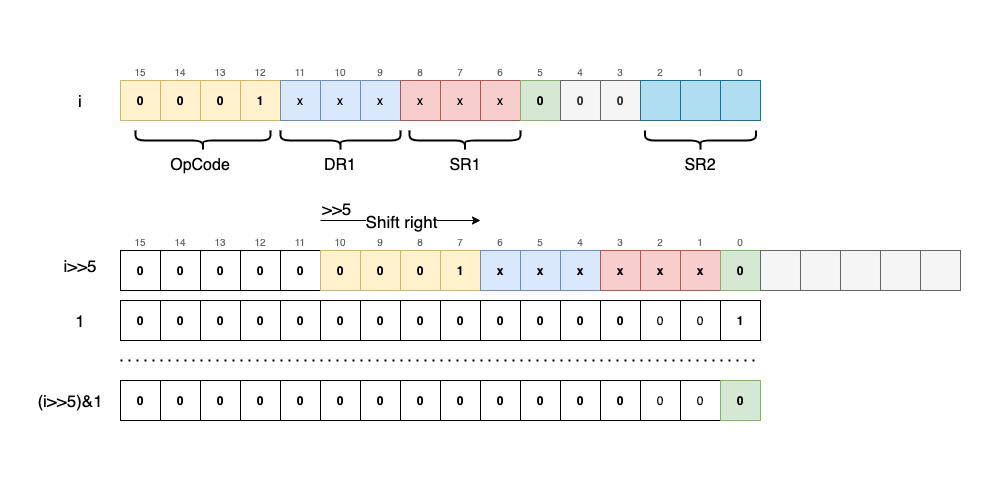
Other useful macros we can use to “extract” SR1, SR2, DR1 and IMM5 are:
#define DR(i) (((i)>>9)&0x7)
#define SR1(i) (((i)>>6)&0x7)
#define SR2(i) ((i)&0x7)
#define IMM(i) ((i)&0x1F)
Explaining each of them it’s not exactly in the scope of this article, but things can become much clearer if you read a good tutorial on bitwise operations. Also, they work quite similar to FIMM; we just use a different mask to get the last 3 bits instead of 1.
All in all, our add function finally looks like this:
static inline void add(uint16_t i) {
reg[DR(i)] = reg[SR1(i)] +
(FIMM(i) ? // If the 5th bit is 1
SEXTIMM(i) : // we sign extend IMM5 and we add it to SR1 (add2)
reg[SR2(i)]); // else we add the value of SR2 to SR1 (add1)
uf(DR(i)); // !! Update the conditional register depending on the value of DR1
}
and - Bitwise logical AND
This instruction is very similar to `add, and it comes in two formats.
The first one (add1) applies binary & on the values of two registers: SR1, SR2, and storing the result in DR1:

The second one (add2) applies binary & between SR1 and IMM5 and stores the result in DR1:

The same idea as before applies; we check bit[5] to determine which format we decode.
From a code perspective, the implementation is more or less the same as the previous one, and re-uses the same macros. We just change the operation from + to &:
static inline void and(uint16_t i) {
reg[DR(i)] = reg[SR1(i)] &
(FIMM(i) ? // If the 5th bit is 1
SEXTIMM(i) : // We sign extend IMM5 and we & it to SR1 (and1)
reg[SR2(i)]); // Otherwise we & the value of SR2 to SR1
uf(DR(i)); // Update the conditional register
}
ld - Load RPC + offset
ld is an instruction to load data from a main memory location to a destination register, DR1. The memory location is obtained by adding to the RPC register an offset value. Calling ld doesn’t modify the RPC; we use RPC just as a referencing point.
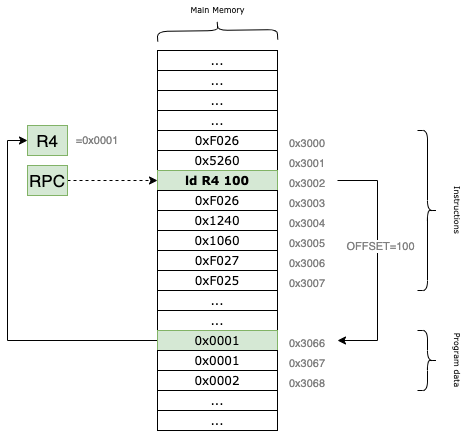
So let’s say the RPC points to the memory address: 0x3002. If the offset is set to 100 we just read the data from location 0x3002+100==0x3066 and load it in the destination register (in our case R4, but this can be everything).
The instruction looks like this:

The associated C code for this functionality is:
#define POFF9(i) sext((i)&0x1FF, 9)
static inline void ld(uint16_t i) {
reg[DR(i)] = mr(reg[RPC] + POFF9(i));
uf(DR(i));
}
The offset is encoded in the last 9 bits of the instruction, this means that the maximum integer value the offset can hold is 2^9-1=512-1=511. So depending on where (and how) the program is stored, some memory areas will remain inaccessible to the ld instruction.
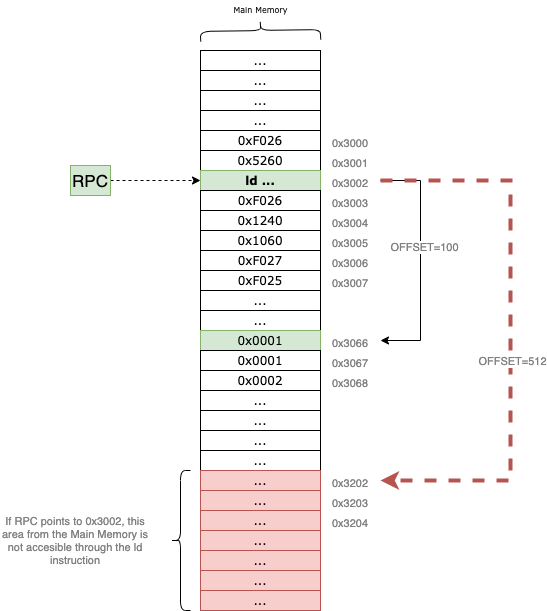
512 in binary is 0b1000000000. As you can see it needs 10 bits for the representation. Thus, the maximum value the offset can have is 511, which in binary can be written as 0b111111111 (9 bits).
To solve this limitation ld has, let’s look at another instruction for loading memory into registers called ldi.
ldi - Load indirect
This instruction is used to load data into registers, using intermediary addresses to access “far-away” memory areas.
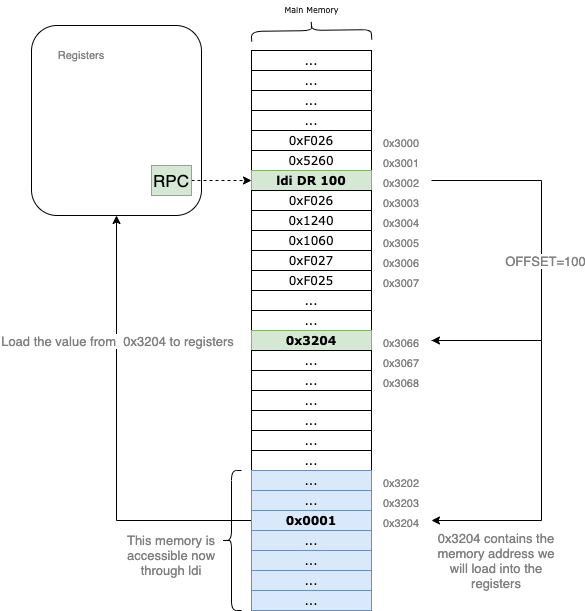
So let’s say the RPC points to 0x3002. Just like before, we use a 9 bit offset to access another memory address at position (RPC+offset). In our case, the offset=100, so the memory address we read is 0x3066.
But instead of loading (directly) 0x3066 into DR, we look at the value contained by 0x3066, which is 0x3204. We now, bring the value of 0x3204 inside the DR.
Using ldi eliminates the issue with the offset’s 9-bit limitation that affects ld.
As a side-note, this doesn’t mean ldi is better than ld, because instead of performing one read, we have to perform two. It just serves another purpose.
The format of the instruction is almost identical to ld, only the OpCode is different:

The C code looks like this:
static inline void ldi(uint16_t i) {
reg[DR(i)] = mr(mr(reg[RPC]+POFF9(i))); // We perform two memory reads
uf(DR(i));
}
ldr - Load Base+Offset
This is another instruction we use to load data into registers, but compared to ld where we start from RPC, this time we can use a different base (by base, we mean a memory address kept in a register).
The format of the instruction is as follows:

To extract BASER from the instruction, we can re-use the macro we’ve firstly defined for ld (SR1(i)), because the bits have the same position.
The extract OFFSET6 from the instruction we will use the following macro:
#define POFF(i) sext((i)&0x3F, 6)
The code is also very similar to ld, with just one small change. Instead of using reg[RPC], we offset from BASER.
static inline void ld(uint16_t i) {
reg[DR(i)] = mr(reg[RPC] + POFF9(i));
uf(DR(i));
}
// VERSUS
static inline void ldr(uint16_t i) {
reg[DR(i)] = mr(reg[SR1(i)] + POFF(i));
uf(DR(i));
}
lea - Load effective address
This instruction helps us load memory addresses into registers. Compared to ld, ldi and ldr, lea doesn’t bring program data into registers, but memory locations.
The format of lea is:

From a visual perspective, the instruction works like this:
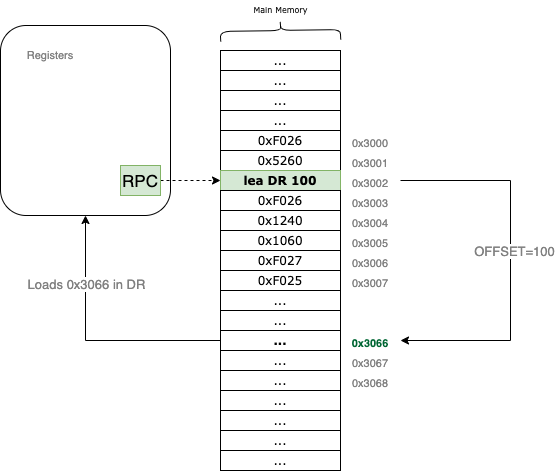
Let’s say the RPC points to 0x3002. The offset9=100, so we load into the DR register the result of 0x3002+100=0x3066.
From a code perspective things are look like this:
static inline void lea(uint16_t i) {
reg[DR(i)] =reg[RPC] + POFF9(i);
uf(DR(i));
}
not - Bitwise complement
This instruction simply performs a bitwise complement ~ on SR1 and stores the value in DR1.
The format of the instruction is:

The corresponding C code is:
static inline void not(uint16_t i) {
reg[DR(i)]=~reg[SR1(i)];
uf(DR(i));
}
st - Store
We use the st instruction to store the value of a given register to a memory location.
The format of the instruction is:

Visually this instruction works like this:
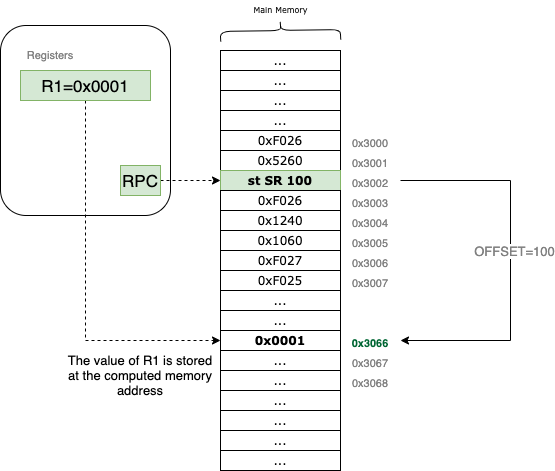
Let’s say RPC is pointing to 0x3002, and SR refers to R1=0x0001. The st instruction will write the value of R1 to RPC+offset.
The C code is straightforward:
static inline void st(uint16_t i) {
mw(reg[RPC] + POFF9(i), reg[DR(i)]); // writes the value of DR(i) to the memory address
}
There’s no need to update any flags because we don’t do any computation on our registers.
Similar to ld before, st suffers from the same memory addressabilitylimitation. In this regard, we introduce a new instruction called sti.
sti - Store indirect
The format of the instruction is similar to st, only the OpCode changes:

The behavior is somewhat different.
Instead of writing to the memory address directly, we use an intermediary address from the main memory to intermediate the write (mw(..)). This secondary address contains the actual memory location where we will write.
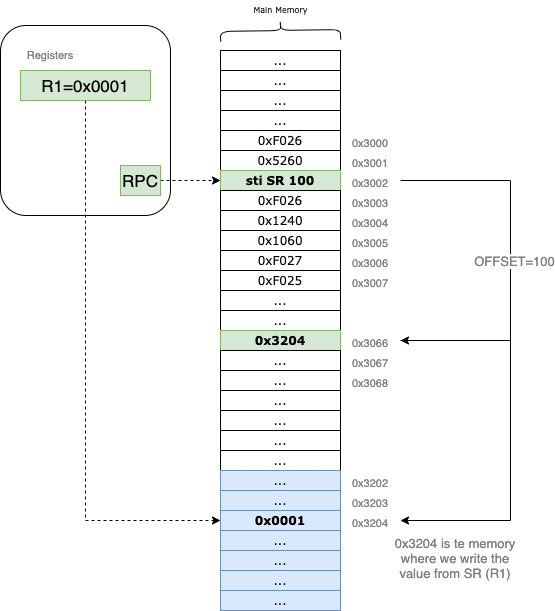
To write the content of R1=0x0001 (SR), to 0x3204, we will first have to read the memory location RPC+offset = 0x3204. Here we will find the value of the address we wish to write to: 3204.
From a code perspective, the implementation in C of sti looks like:
static inline void sti(uint16_t i) {
mw(mr(reg[RPC] + POFF9(i)), reg[DR(i)]);
}
str - Store base + offset
This instruction is similar st, with one difference. Instead of starting from RPC we can specify another base as the reference register (BASER), to which we add the offset (OFFSET6).
The format of the instruction is the following:

The C code:
static inline void st(uint16_t i) {
mw(reg[RPC] + POFF9(i), reg[DR(i)]);
}
// VERSUS
static inline void str(uint16_t i) {
mw(reg[SR1(i)] + POFF(i), reg[DR(i)]);
}
jmp - Jump
Typically, the RPC register auto-increment after each instruction gets executed.
jmp is an instruction that makes our RPC jump to the location specified by the contents of the BASER (base register).
The format is the following:

And visually the instruction works like this:
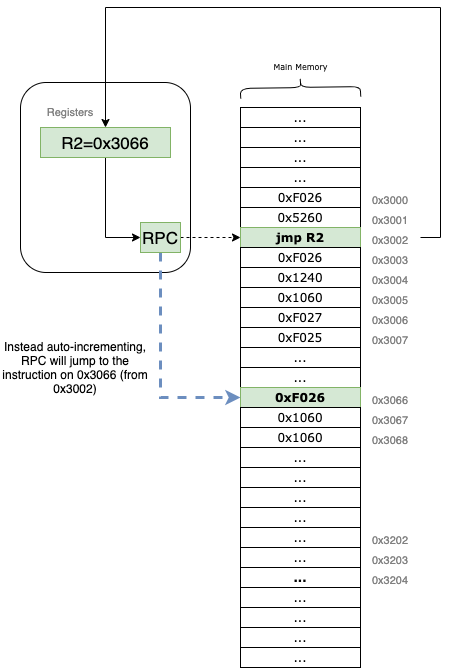
Let’s say our RPC=0x3002, and R2=0x3066 (this is BASER). When the jmp instruction is encountered, RPC will jump directly to the memory address kept in BASER (R2=0x3066), and the program flow will continue.
In some high-level programming languages, jmp is similar to a go to statement.
The corresponding C code is:
static inline void jmp(uint16_t i) {
reg[RPC] = reg[BR(i)];
}
jsr - Jump to subroutines
jsr is a control flow instruction that helps us implement subroutines.
Subroutines in (our) ASM are similar to functions from a high-level programming language. They can be viewed as a series of instructions and their starting. They have an input (expect to read data from registers), and an output (they put the return value to a register).
jsr comes into two formats:
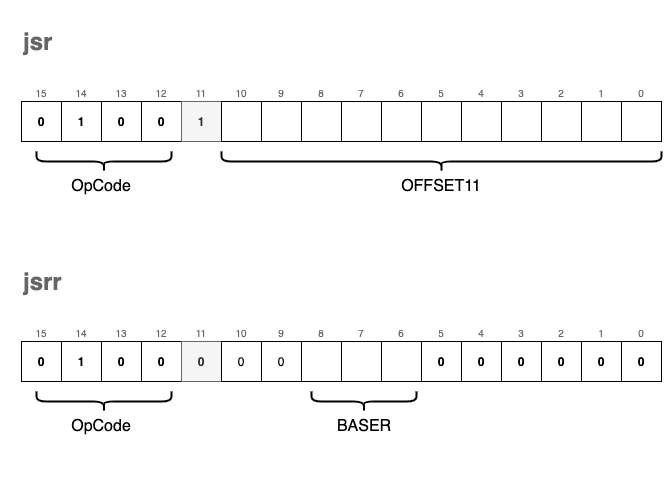
The pseudo-code for the operation is as follows:
- We save the
RPCinR7(to remember from where we branch); - If
bit[11]is set to0then we set theRPC = BASER; - If
bit[11]is set to1then setRPC = RPC + OFFSET11;
The associated C code is the following:
static inline void jsr(uint16_t i) {
reg[R7] = reg[RPC];
reg[RPC] = (FL(i)) ? // Checks bit[11]
reg[RPC] + POFF11(i) : // rpc + offset
reg[BR(i)]; // base register
}
The visual explanation for this instruction looks like this:
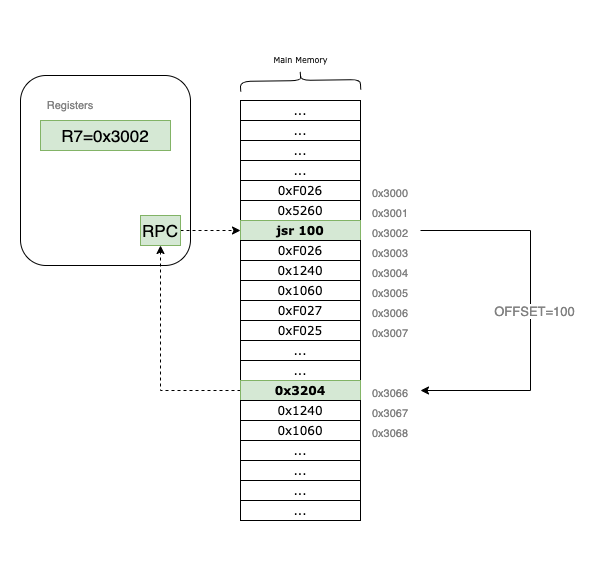
In the above example, RPC is initially set to 3002. At this position, it’s a jsr instruction. We store RPC in R7 to remember from where we branched off. Then we jump with the required offset=100, to position 0x3066, and we update RPC to this.
br - Conditional branch
This instruction works similar to jsr, but there’s one big difference, the branching happens only if some conditions are met.
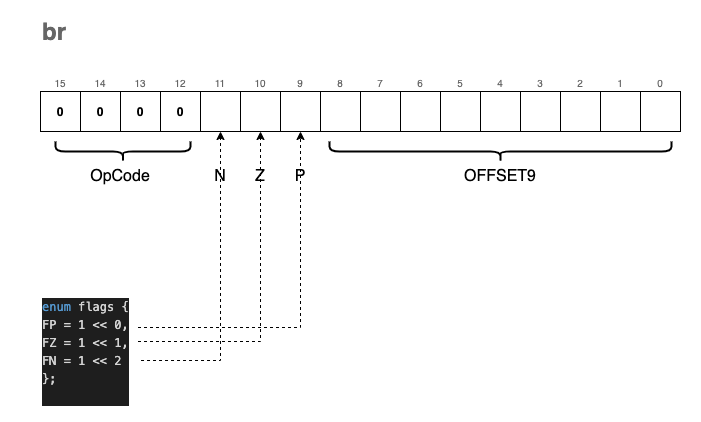
If you look closer, the NZP bits are not accidentally named like this. They are used to reflect the changes we are making with uf(...) on RCND:
enum flags { FP = 1 << 0, FZ = 1 << 1, FN = 1 << 2 };
static inline void uf(enum regist r) {
if (reg[r]==0) reg[RCND] = FZ; // the value in r is zero
else if (reg[r]>>15) reg[RCND] = FN; // the value in r is z negative number
else reg[RCND] = FP; // the value in r is a positive number
}
Basically all the possible values of RCND are FP=001, FZ=010 or FN=100. When implementing our C code for br we can easily take this into consideration, and compare the NZP segment of the instruction with RCND:
#define FCND(i) (((i)>>9)&0x7)
static inline void br(uint16_t i) {
if (reg[RCND] & FCND(i)) { // if the condition is met
reg[RPC] += POFF9(i); // branch to offset
}
}
trap
This instruction is more complex than the rest because it enables us to interact with I/0 and, theoretically, other devices.

In the TRAPVECT we keep an index to other functions that offer us the possibility to read numbers and strings from stdin and write them on stdout.
Each trap will be kept in an array trp_ex that contains pointers to the associated C functions. We follow the same strategy as we did with the instructions, but we will use a separate array.
If we would’ve kept things kosher, traps should’ve been implemented in ASM, and we would’ve implemented another mechanism to interact with the keyboard and stdout.
Anyway, this is how the code is structured:
#define TRP(i) ((i)&0xFF)
static inline void tgetc() { /* code */ }
static inline void tout() { /* code */ }
static inline void tputs() { /* code */ }
static inline void tin() { /* code */ }
static inline void tputsp() { /* code */ }
static inline void thalt() { /* code */ }
static inline void tinu16() { /* code */ }
static inline void toutu16() { /* code */ }
enum { trp_offset = 0x20 };
typedef void (*trp_ex_f)();
trp_ex_f trp_ex[8] = { tgetc, tout, tputs, tin, tputsp, thalt, tinu16, toutu16 };
static inline void trap(uint16_t i) {
trp_ex[TRP(i)-trp_offset]();
}
In total, there are 8 supported trap functions:
| Trap Function | TRAPVECT | trp_ex[] index |
Comments |
|---|---|---|---|
tgetc |
0x20 |
0 | Reads a character (char) from the keyboard that get copied in R0 |
tout |
0x21 |
1 | Writes the character (char) from R0 to the console. |
tputs |
0x22 |
2 | Writes a string of characters to the console. As a rule, the characters are kept in a contiguous memory location, one char per memory location. Starting with the address specified in R0. If 0x0000 is encountered, printing stops. |
tin |
0x23 |
3 | Reads a character (char) from the keyboard, and it gets copied in R0. Afterward, the char is printed on the console. |
tputsp |
0x24 |
4 | Not implemented. This trap is used to store 2 characters per memory location instead of 1. Otherwise, it works like tputs. It’s left out as an exercise. |
thalt |
0x25 |
5 | Halts execution of the program. The VM stops. |
tinu16 |
0x26 |
6 | Reads a uint16_t from the keyboard and stores it in R0. |
toutu16 |
0x27 |
7 | Writes the uint16_t found inside R0. |
Now, let’s see how each method is implemented.
tgetc
We simply use getchar() and stores the returning character to R0:
static inline void tgetc() { reg[R0] = getchar(); }
toutc
We print the R0 to stdout:
static inline void tout() { fprintf(stdout, "%c", (char)reg[R0]); }
tputs
We iterate through the memory location starting at R0 until we find 0x0000 and print each character in order:
static inline void tputs() {
uint16_t *p = mem + reg[R0];
while(*p) {
fprintf(stdout, "%c", (char)*p);
p++;
}
}
tin
This method is almost identical to tgetc, with one small difference, we print the char after storing it inside R0:
static inline void tin() { reg[R0] = getchar(); fprintf(stdout, "%c", reg[R0]); }
thalt
To keep track of the running VM, we keep a global bool variable called running. Once thalt is invoked, running is set to false, and the machine automatically stops:
static inline void thalt() { running = false; }
tinu16
We read the uint16_t from keyboard and we store it inside R0:
static inline void tinu16() { fscanf(stdin, "%hu", ®[R0]); }
toutu16
We write the uint16_t content of R0 to the console:
static inline void toutu16() { fprintf(stdout, "%hu\n", reg[R0]); }
Loading and running programs
Congratulations, if you kept coding while you were reading this article, at this point you have a working toy-VM, capable of running simple programs written in our ASM language.
We have only two missing functionalities: the main loop and the ability to load programs.
The main loop of our VM looks like this:
bool running=true;
uint16_t PC_START = 0x3000;
void start(uint16_t offset) {
reg[RPC] = PC_START + offset; // The RPC is set
while(running) {
uint16_t i = mr(reg[RPC]++); // We extract instructions from the memory
// location pointed by RPC
// We (auto)increment RPC
op_ex[OPC(i)](i); // We execute each instruction
}
}
Now, the only thing left missing is the ability to load programs into our VM in this regard we will write a ld_img method capable of loading binary files directly into our main memory:
void ld_img(char *fname, uint16_t offset) {
// Open (binary) file containing the VM program
FILE *in = fopen(fname, "rb");
if (NULL==in) {
fprintf(stderr, "Cannot open file %s.\n", fname);
exit(1);
}
// The position from were we start copying the file
// to the main memory
uint16_t *p = mem + PC_START + offset;
// Load the program in memory
fread(p, sizeof(uint16_t), (UINT16_MAX-PC_START), in);
// Close the file stream
fclose(in);
}
This method returns void and accepts two input parameters:
- The path to the binary file containing our program;
- The offset from where we start loading the first program instruction into the main memory.
The main method of our VM looks like this:
int main(int argc, char **argv) {
ld_img(argv[1], 0x0);
start(0x0);
return 0;
}
Our first program
Our first program will not be "Hello, world!", but something more exciting: a complex software that reads two numbers from the keyboard and prints their sum to stdout.
Jokes aside, here how it looks:
0xF026 // 1111 0000 0010 0110 TRAP tinu16 ;read an uint16_t in R0
0x1220 // 0001 0010 0010 0000 ADD R1,R0,x0 ;add contents of R0 to R1
0xF026 // 1111 0000 0010 0110 TRAP tinu16 ;read an uint16_t in R0
0x1240 // 0001 0010 0010 0000 ADD R1,R1,R0 ;add contents of R0 to R1
0x1060 // 0001 0000 0110 0000 ADD R0,R1,x0 ;add contents of R1 to R0
0xF027 // 1111 0000 0010 0111 TRAP toutu16 ;show the contents of R0 to stdout
0xF025 // 1111 0000 0010 0101 HALT ;halt
The syntax is not user friendly, isn’t it ? Our program is actually this series of numbers: 0xF026 0x1220 0xF026 0x1240 0x1060 0xF027 0xF025. But if we look closer, in those numbers we’ve been encoding ASM instructions.
For example, let’s look at this number 0xF026. Its binary representation is 1111 0000 0010 0110. It is easy to spot 1111 as the encoding for trap, and the TRAPVECT, 100111, corresponding to tinu16.
Or for a more visual representation, let’s analyze 0x1220:
0x1220 ->
0001 001 000 1 00000
ADD R1 R0 IMM5=0
Running our first program
Bad news, there’s no compiler. We will have to write programs by hand, with pen and paper (like the people in the old days).
The good news is we don’t need a compiler to generate a binary file that our VM can run. We can write a C program for that.
The main idea is to keep our instructions in an array (uint16_t program[]), and then use fwrite() to generate the binary file, which we can further load with ld_img().
#include <stdio.h>
#include <stdlib.h>
uint16_t program[] = {
/*mem[0x3000]=*/ 0xF026, // 1111 0000 0010 0110 TRAP trp_in_u16 ;read an uint16_t from stdin and put it in R0
/*mem[0x3002]=*/ 0x1220, // 0001 0010 0010 0000 ADD R1,R0,x0 ;add contents of R0 to R1
/*mem[0x3003]=*/ 0xF026, // 1111 0000 0010 0110 TRAP trp_in_u16 ;read an uint16_t from stdin and put it in R0
/*mem[0x3004]=*/ 0x1240, // 0001 0010 0010 0000 ADD R1,R1,R0 ;add contents of R0 to R1
/*mem[0x3006]=*/ 0x1060, // 0001 0000 0110 0000 ADD R0,R1,x0 ;add contents of R1 to R0
/*mem[0x3007]=*/ 0xF027, // 1111 0000 0010 0111 TRAP trp_out_u16;show the contents of R0 to stdout
/*mem[0x3006]=*/ 0xF025, // 1111 0000 0010 0101 HALT ;halt
};
int main(int argc, char** argv) {
char *outf = "sum.obj";
FILE *f = fopen(outf, "wb");
if (NULL==f) {
fprintf(stderr, "Cannot write to file %s\n", outf);
}
size_t writ = fwrite(program, sizeof(uint16_t), sizeof(program), f);
fprintf(stdout, "Written size_t=%lu to file %s\n", writ, outf);
fclose(f);
return 0;
}
If we compile and run the above program, a binary file called "sum.obj" will be generated.
Then we can use our VM to load it and run it:

The current git repo contains another program: simple_program.c which sums up the numbers in an array. If you are curious about it, you can run it yourself.
Final thoughts
First of all, thank you for reading up until this point, and congratulations on the fact you have a running VM.
Writing a simple toy like this is simple, but creating something remotely useful is hard work and involves much more than we’ve covered up until this point.
Maybe in another article, we will implement a Stack-Based VM, or a modern hybrid between the two.
After submitting this article on various communities (btw, feedback was amazing), people constructively suggested the naming conventions are confusing: functions names are too short, code is too terse, etc.
I wouldn’t usually name things like I did here, but given the fact that the program, in essence, is short, contained, and geared towards the low-level world of ASM (Where things have non-modern naming conventions), it was more natural for me to write the code like this. On short, the code was not imagined to be easily understood without this companion article aside.

Comments